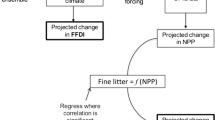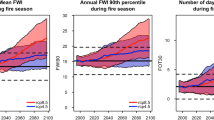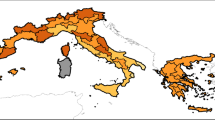Abstract
High-temporal resolution meteorological output from the Parallel Climate Model (PCM) is used to assess changes in wildland fire danger across the western United States due to climatic changes projected in the 21st century. A business-as-usual scenario incorporating changing greenhouse gas and aerosol concentrations until the year 2089 is compared to a 1975–1996 base period. Changes in relative humidity, especially dryingover much of the West, are projected to increase the number of days of high fire danger (based on the energy release component (ERC) index) at least through the year 2089 in comparison to the base period. The regions most affected are the northern Rockies, Great Basin and the Southwest –regions that have already experienced significant fire activity early this century. In these regions starting around the year 2070, when the model climate CO2 has doubled from present-day, the increase in the number ofdays that ERC (fuel model G) exceeds a value of 60 is as much as two to three weeks. The Front Range of the Rockies and the High Plains regions do not show a similar change. For regions where change is predicted, new fire and fuels management strategies and policies may be needed to address added climatic risks while also accommodating complex and changing ecosystems subject to human stresses on the region. These results, and their potential impact on fire and land management policy development, demonstrate the value of climate models for important management applications, as encouraged under the Department of Energy Accelerated Climate Prediction Initiative (ACPI), under whose auspices this work was performed.
Similar content being viewed by others
References
Aber, J., Neilson, R. P., McNulty S., Lenihan, J. M., Bachelet, D., and Drapek, R. J.: 2001, ‘Forest Processes and Global Environmental Change: Predicting the Effects of Individual and Multiple Stressors’, BioScience 9, 735–751.
Agee, J. K.: 1993, Fire Ecology of Pacific Northwest Forests, Island Press, Washington D.C., 493 pp.
Agee, J. K.: 1997, ‘The Severe Weather Wildfire: Too Hot to Handle?’, Northwest Science 71, 153–156.
Bachelet, D., Neilson, R. P., Lenihan, J. M., and Drapek, R. J.: 2001, ‘Climate Change Effects on Vegetation Distribution and Carbon Budget in the United States’, Ecosystems 4, 164–185.
Bergeron, Y. and Flannigan, M. D.: 1995, ‘Predicting the Effects of Climate Change on Fire Frequency in the Southeastern Canadian Boreal Forest’, Water Air Soil Pollut. 82, 437–444.
Bradshaw, L. S., Deeming, J. E., Burgan, R. E., and Cohen, J. D.: 1983, 1978 National Fire-Danger Rating System–Technical Documentation, Gen. Tech. Rep. INT-169, Intermountain Forest and Range Experiment Station, U.S. Department of Agriculture Forest Service, 44 pp.
Cohen, J. D. and Deeming, J. E.: 1985, The National Fire-Danger Rating System: Basic Equations, Gen. Tech. Rep. PSW-82, Pacific Southwest Forest and Range Experiment Station, U.S. Department of Agriculture, Forest Service, 16 pp.
Dai, A., Wigley, T. M.L, Boville, B. A., Kiehl, J. T., and Buja, L. E.: 2001, ‘Climates of the Twentieth and Twenty-First Centuries Simulated by the NCAR Climate System Model’, J. Climate 14, 485–519.
Dai, A., Washington, W., Meehl, G., Bettge, T., and Strand, W.: 2004, ‘The ACPI Climate Change Simulations’, Clim. Change 62, 29–43.
Deeming, J. E., Burgan, R. E., and Cohen, J. D.: 1977, The National Fire-Danger Rating System–1978, Gen. Tech. Rep. INT-39, Intermountain Forest and Range Experiment Station, U.S. Department of Agriculture Forest Service, 63 pp.
Donnegan, J. A., Veblen, T. T., and Sibold, S. S.: 2001, ‘Climatic and Human Influences on Fire History in Pike National Forest, Central Colorado’, Can. J. Forest Res. 31, 1527–1539.
Flannigan, M. D., Stocks, B. J., and Wotton, B. M.: 2000, ‘Climate Change and Forest Fires’, Sci. Total Environ. 262, 221–229.
Flannigan, M. D. and Van Wagner, C. E.: 1990, ‘Climate Change and Wildfire in Canada’, Can. J. Forest Res. 21, 66–72.
Foley, J. A., Prentice, I. C., Ramankutty, N., Levis, S., Pollard, D., Sitch, S., and Haxeltine, A.: 1996, ‘An Integrated Biosphere Model of Land Surface Processes, Terrestrial Carbon Balance, and Vegetation Dynamics’, Global Biogeochem. Cycles 10, 603–628.
Habeck, J. R.: 1985, ‘Impact of Fire Suppression on Forest Succession and Fuel Accumulations in Long-Fire-Interval Wilderness Habitat Types’, in Lotan, J. E., Kilgore, B. M., Fischer, W. C., and Mutch R. W. (eds.), Proceedings of the Symposium and Workshop on Wilderness Fire, GTR INT-182, U.S. Forest Service, Intermountain Forest and Range Experiment Station, pp. 110–118.
IPCC: 1995, Climate Change 1995: Impacts, Adaptations, and Mitigation of Climate Change: Scientific-Technical Analyses, Watson, R. T., Zinyowera, M. C., and Moss, R. H. (eds.), Cambridge University Press, Cambridge, 879 pp.
IPCC: 2001, Climate Change 2001: The Scientific Basis, Houghton, J. T., Ding, Y., Griggs, D. J., Noguer, M., van der Linden, P. J., Dai, X., Maskell, K., and Johnson, C. A. (eds.), Cambridge University Press, Cambridge, 879 pp.
Johnson, E. A., Miyanishi, K., and Bridge S. R. J.: 2001 ‘Wildfire Regime in the Boreal Forest and the Idea of Suppression and Fuel Buildup’, Conservation Biology 15, 1554–1557.
Karl, T. R., Knight, R. W., Easterling, D. R., and Quayle, R. G.: 1996, ‘Indices of Climate Change for the United States’, Bull. Amer. Meteorol. Soc. 77, 279–292.
Keeley, J. E. and Fotheringham, C. J.: 2001, ‘History and Management of Crown-Fire Ecosystems: A Summary and Response’, Conservation Biology 15, 1561–1567.
Kipfmueller, K. F. and Swetnam, T. W.: 2000, ‘Fire-Climate Interactions in the Selway-Bitterroot Wilderness Area’, USDA Forest Service Proceedings RMRS-P-15-Vol-5.
Leggett, J. A., Pepper, W. J., and Swart, R. J.: 1992, ‘Emissions Scenarios for IPCC: An Update’, Climate Change 1992: The Supplementary Report to the IPCC Scientific Assessment, Houghton, J. T., Callander, B. A., and Varney, S. K. (eds.), Cambridge University Press, Cambridge, pp. 69–95.
Leniham, J. M., Daly, C., Bachelet, D., and Neilson, R. P.: 1998, ‘Simulating Broad-Scale Fire Severity in a Dynamic Global Vegetation Model’, Northwest Science 72, 91–103.
McKenzie, D., Peterson, D. L., and Alvarado, E.: 1996, ‘Extrapolation Problems in Modeling Fire Effects at Large Spatial Scales: A Review’, Int. J. Wildland Fire 6, 165–176.
Neilson, R. P. and Drapek, R. J.: 1998, ‘Potentially Complex Biosphere Responses to Transient Global Warming’, Global Change Biology 4, 505–521.
Neilson, R. P. and Running, S. W.: 1996, ‘Global Dynamic Vegetation Modeling: Coupling Biogeochemistry and Biogeography Models’, in Walker, B. and Steffen W. (eds.), Global Change and Terrestrial Ecosystems, Cambridge University Press, Cambridge, pp. 451–465.
Overpeck, J. T., Rind, D., and Goldberg, R.: 1990, ‘Climate-Induced Changes in Forest Disturbance and Vegetation’, Nature 343, 51–53.
Pierce, D.W., Barnett, T. P., Tokmakian, R., Semtner, A., Maltrud, M., Lysne, J., and Craig, A.: 2004, ‘The ACPI Project, Element 1: Initializing a Coupled ClimateModel from Observed Conditions’, Clim. Change 62, 13–28.
Price, C. and D. Rind: 1994, ‘Possible Implications of Global Climate Change on Global Lightning Distributions and Frequencies’, J. Geophys. Res. 99, 10823–10831.
Pyne, S. J., Andrews, P. J., and Laven, R. D.: 1996, Introduction to Wildland Fire, 2nd edn., John Wiley and Sons, New York, 769 pp.
Ryan, K. C.: 2000, ‘Global Change and Wildland Fire’, in Brown, J. K. and Kapler Smith, J. (eds.), Wildland Fire in Ecosystems: Effects of Fire on Flora, Gen. Tech. Rep. RMRS-GTR-42-Vol. 2, U.S. Department of Agriculture, Forest Service, Rocky Mountain Research Station, pp. 175–183.
Stewart, I. T., Cayan, D. R., and Dettinger, M. D.: 2004, ‘Changes in Snowmelt Runoff Timing in Western North America under a “Business as Usual” Climate Change Scenario’, Clim. Change 62, 217–232.
Stocks, B. J., Fosberg, M. A., Lynham, T. J., Mearns, L., Wotton, B. M., Yang, Q., Jin, J-Z., Lawrence, K., Hartley, G. R., Mason, J. A., and McKenney, D. W.: 1998, ‘Climate Change and Forest Fire Potential in Russian and Canadian Boreal Forests’, Clim. Change 38, 1–13.
Swetnam, T. W. and Betancourt, J. L.: 1998, ‘Mesoscale Disturbance and Ecological Response to Decadal Climatic Variability in the American Southwest’, J. Climate 11, 3128–3147.
Thonicke, K, Venevsky, S., Sitch, S., and Cramer, W.: 2001, ‘The Role of Fire Disturbance for Global Vegetation Dynamics: Coupling Fire into a Dynamic Global Vegetation Model’, Global Ecology and Biogeography 10, 661–677.
Torn, M. S. and Fried, J. S.: 1992, ‘Predicting the Impacts of Global Warming on Wildland Fire’, Clim. Change 21, 257–274.
Washington, W. M., Weatherly, J. W., Meehl, G. A., Semtner, A. J., Bettge, T.W., Craig, A. P., Strand, W. G. Jr., Arblaster, J., Wayland, V. B., James, R., and Zhang, Y.: 2000, ‘Parallel Climate Model (PCM) Control and Transient Simulations’, Clim. Dyn. 16, 755–774.
Weber, M. G. and Flannigan, M. D.: 1997, ‘Canadian Boreal Forest Ecosystem Structure and Function in a Changing Climate: Impact on Fire Regimes’, Environ. Rev. 5, 145–166.
Woodward, F.I., Smith, T. M., and Emmanuel, W. R.: 1995, ‘A Global Land Primary Productivity and Phytogeography Model’, Global Biogeochem. Cycles 9, 471–490.
Wotton, B. M. and Flannigan, M. D.: 1993, ‘Length of the Fire Season in a Changing Climate’, For. Chron. 69, 187–192.
Author information
Authors and Affiliations
Rights and permissions
About this article
Cite this article
Brown, T.J., Hall, B.L. & Westerling, A.L. The Impact of Twenty-First Century Climate Change on Wildland Fire Danger in the Western United States: An Applications Perspective. Climatic Change 62, 365–388 (2004). https://doi.org/10.1023/B:CLIM.0000013680.07783.de
Issue Date:
DOI: https://doi.org/10.1023/B:CLIM.0000013680.07783.de




